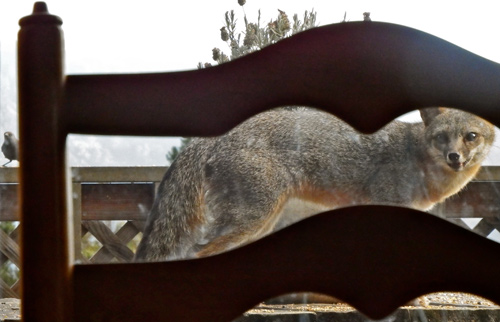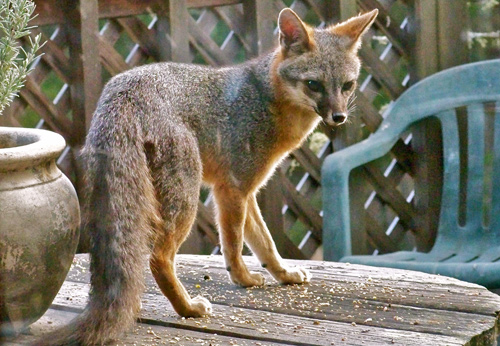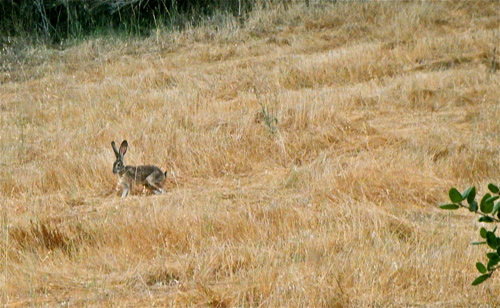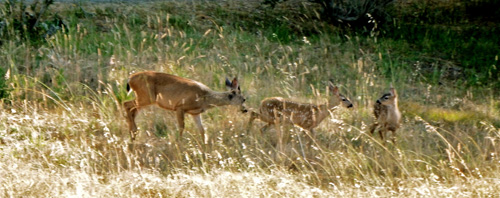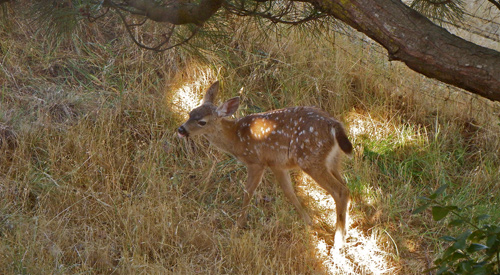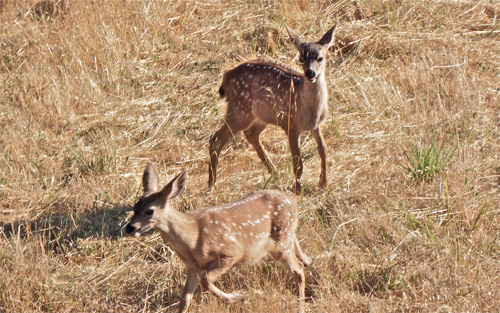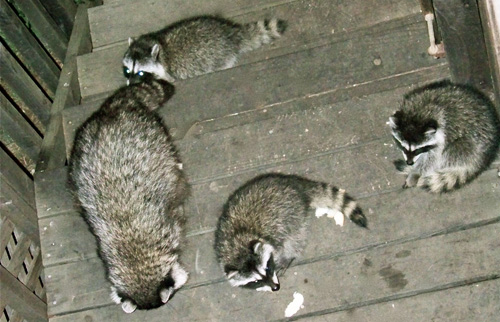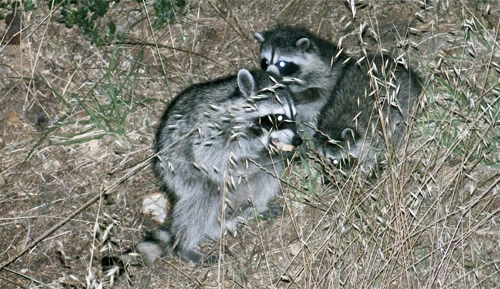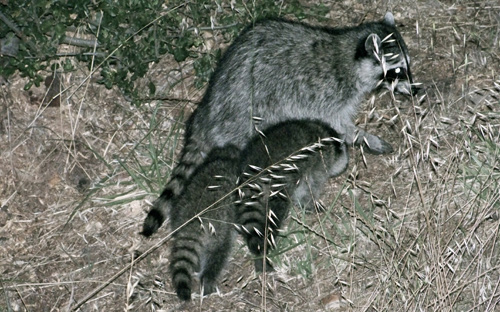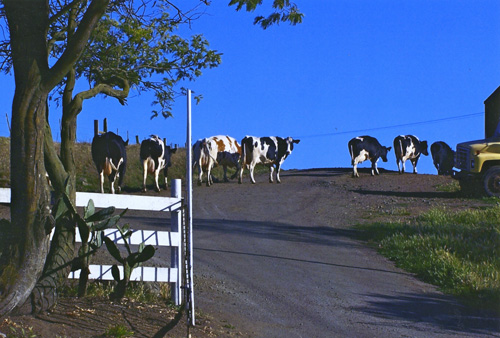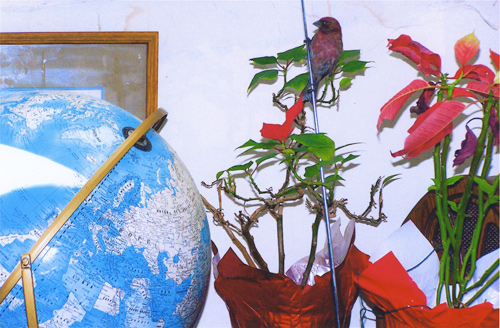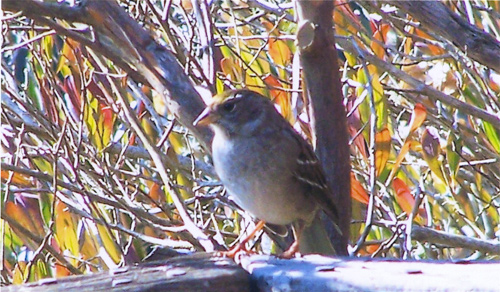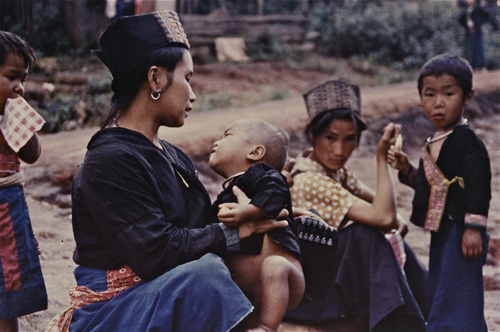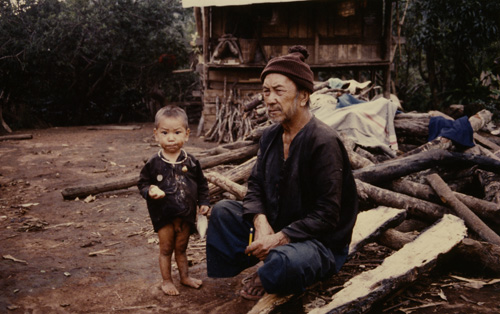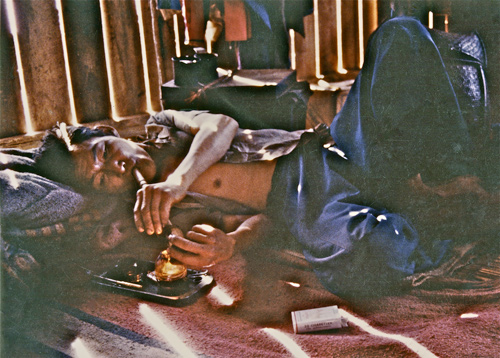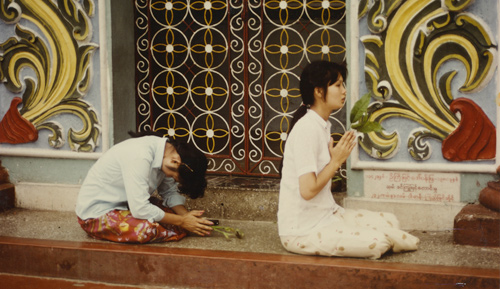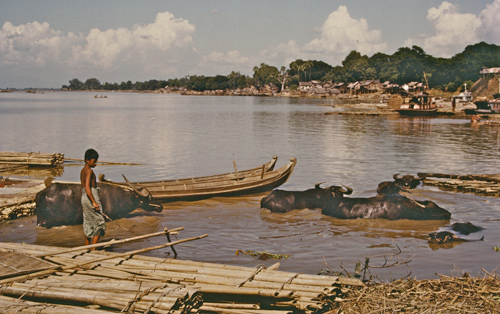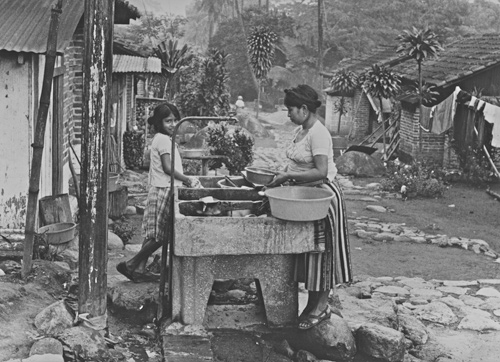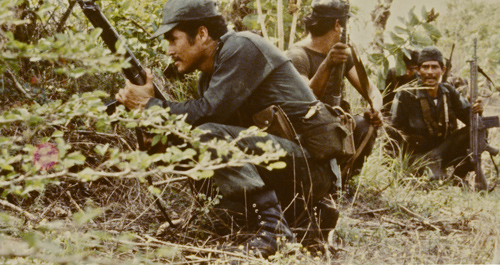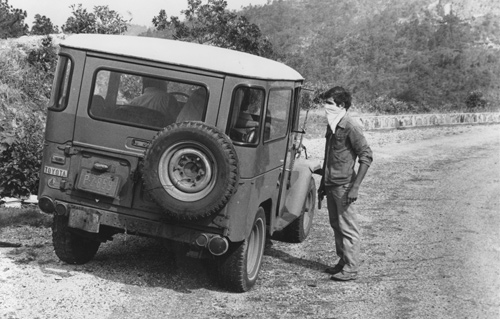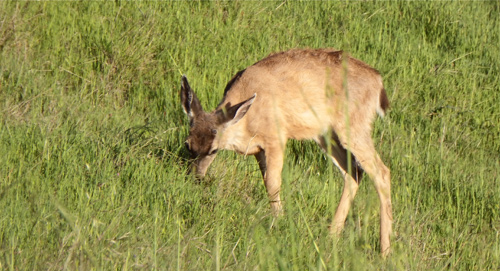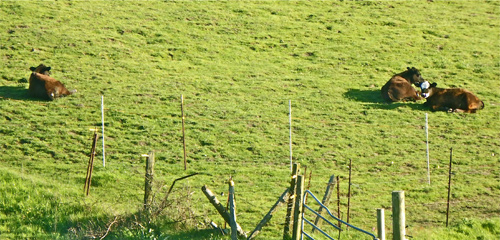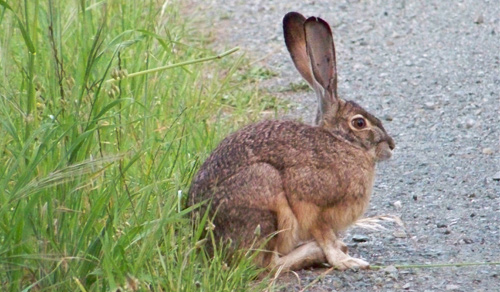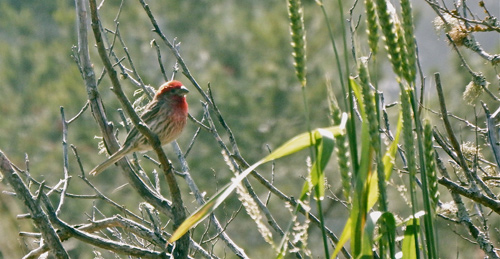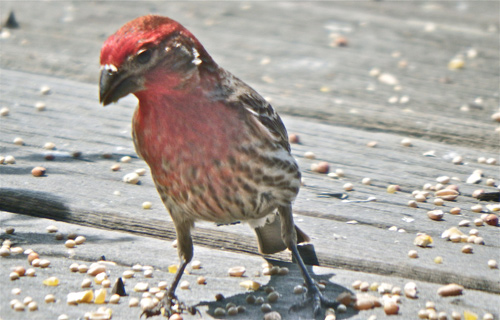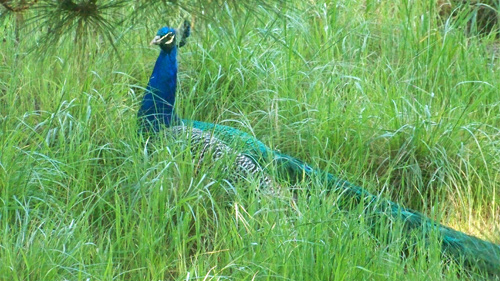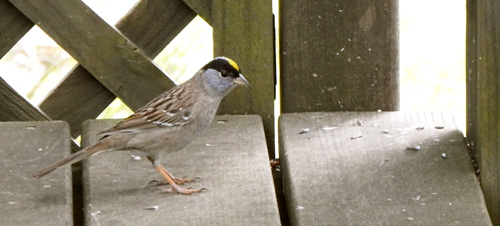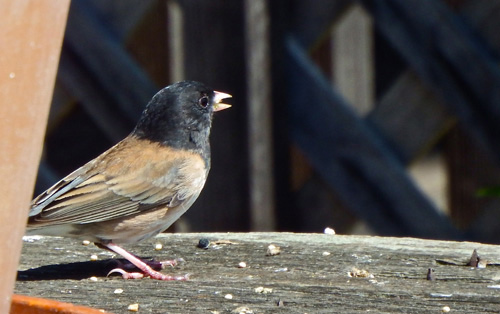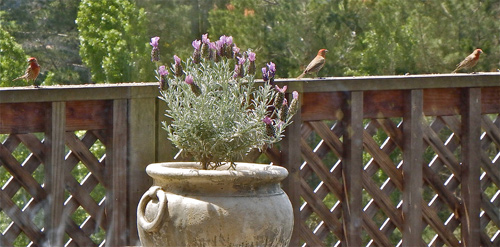Entries tagged with “House finch”.
Did you find what you wanted?
Sun 20 Jul 2014
The old dichotomy of “nature v. nurture” may be a false one. As a couple of photos shot at Mitchell cabin last week demonstrate, nature also nurtures its own.
These photos are hardly remarkable in and of themselves, but they record what a remarkable variety of nature is just outside my window.

The sunset on July 14 gave the western sky the dazzle of a technicolor movie.

Even more dazzling was this simultaneous rainbow in the eastern sky. Numerous people around Point Reyes Station saw it, and several posted photos of the rainbow on West Marin Feed-Facebook.

After relentless begging with its beak open and its wings fluttering, a juvenile blackbird finally gets a parent to feed it birdseed even though it’s perfectly capable of feeding itself.

Last week Lynn spotted a fox on our picnic table peering in our living room between the slats of a chair. Its presence kept the blackbird at left on the railing and off the table.

The Gray fox was on the table to eat seed Lynn had scattered for the birds.

Staying well away from the fox, a jackrabbit eats grass just outside our kitchen window.

A doe and her fawns can be seen around Mitchell cabin virtually every day.

One of the sweetest-looking little animals around, a blacktail fawn walks past our bedroom window.

Fawns seem to be often on the run. At their age, it would appear, they enjoy being able to dash from here to there.

A young blacktail buck grazes by itself in the field below our deck.

A cross between a House sparrow and a Great horned owl?
Lynn and I correctly guessed the bird is actually a young House finch, but we had no explanation for its “horns,” so we dropped by the Point Reyes Station office of the Institute for Bird Populations.
Dave DeSante, the institute’s president and founder, was in the office, and we asked him what was going on with this bird. After pondering the bird’s unlikely appearance, he concluded the horns are actually pin feathers that somehow got ruffled on opposite sides of the finch’s head.

An adult, male House finch eats birdseed next to our birdbath. As I noted here back in May, their coloration is derived from the fruits and berries in their diets. Adult female house finches tend to be light brown with white streaks.

Nor is all peaceful around Mitchell cabin. A redtailed hawk, believe it was this one, killed a collared dove on our deck last week. We heard the impact when it swooped down and seized the dove, leaving behind a mass of white feathers as evidence of nature’s savagery.

A raccoon, which had been showing up each evening on our deck begging for scraps of bread, showed up this past week with three kits in tow. No wonder she’d been looking so tired of recent.

Here the raccoons scour the grass around the deck for slices of bread Lynn threw there to keep them away from another, feisty raccoon on the deck.

And while the kits are perfectly able to eat bread, they still try to get mom to nurse them. They sort of remind me of juvenile blackbirds that want to be nurtured.
Sun 11 May 2014
Posted by DavidMitchell under Photography
Comments Off on A few of my photos in war and peace from West Marin to Southeast Asia to Central America
“Every picture tells a story, don’t it?” Rod Stewart

Cows heading toward the milking barn at Steve and Sharon Doughty’s ranch in Point Reyes Station. Of all the photos I’ve shot of West Marin agriculture, this is my favorite (2004).

The newsroom of The Point Reyes Light when the newspaper was located in Point Reyes Station’s Old Creamery Building (2004).
One day I heard something banging around in the firebox of the newsroom’s potbellied stove, which was not lit, so I opened the door to look inside. This house finch, which had apparently fallen down the chimney, flew out and started flying around the room, banging into the closed skylights.
I opened a skylight, but the finch didn’t fly out. Instead it landed on the antenna to our weather radio and perched there looking out over the world. The scene seemed so symbolic he could have been an avian journalist.
Before long a house finch outside the building began singing. The one inside sang back. After several seconds of their calling back and forth, the finch in the newsroom finally flew out the open skylight.

A Golden-crowned sparrow disguised as a stained-glass window, Point Reyes Station (2004).

Scotty’s Castle in Death Valley (2005).
The castle was built in the 1920s by Albert Mussey Johnson, a millionaire from Chicago. Scotty (Walter Scott) was a con man, who took advantage of Johnson, as well as others. Nonetheless, Johnson kept Scotty around to entertain guests with his storytelling.

Thailand (1986).
Two mothers and their children in one of Thailand’s semi-isolated hilltribes.

A Thai hilltribe father and his son (1986).
The father is holding a Point Reyes Light ballpoint pen, which I had given him. The pens were made in 1979 to commemorate the paper’s winning the Pulitzer Prize for Meritorious Public Service.

Thailand’s hilltribes grow opium poppies, as well as bananas and other crops. Here a man in his hut without windows, only gaps between wall boards for light, smokes opium in a pipe (1986).

Rangoon, Burma (1986).
Two Buddhists pray outside the Shwedagon Pagoda. In 1989, the military government changed the country’s name to Myanmar because Burma was the name the British used when the country was their colony. Some citizens, however, question the military’s right to change their country’s name, and many continue to use the name Burma. The name comes from the name of the country’s largest ethnic group, the Bamar.

Mandalay, Burma (1986).
Buddhist monks in Thailand and Burma are considered novices before they turn 20. Most live monastic lives for only short periods, a few years or even just a few days. Youths receive schooling inside or outside of their temple. Helping take care of the temple is one of their main responsibilities. Novices are not expected to be continually solemn, and these boys felt free to roughhouse with each other.

Boy tending water buffalo at the edge of the Irrawaddy River at Mandalay (1986).

Guatemala (1982).
Two Mayan girls wash dishes at a pila (outdoor trough) because their homes on a finca (plantation) lack running water. For many women in rural villages, washing dishes and clothes together at a community pila is their primary time to socialize.

El Salvador (1983).
Government forces take cover during a firefight with FMLN guerrillas. The government patrol, which had been fighting all night, was exhausted and retreating under fire.

Guerrilla-held territory, El Gramal, El Salvador (1983).
A guerrilla stops a vehicle belonging to Antel, the government-owned phone company, and then sends it on its way. Earlier in the day, an Antel driver divulged a bizarre arrangement whereby the guerrillas regularly borrowed the four-wheel-drive Toyota for night patrols but returned it to Antel in the morning. Such cooperation probably explained why an Antel manager in El Gramal said the government phone company in his area was able to operate as usual even though Popular Liberation Front guerrillas had by then occupied the region for six months.
Tags: Albert Mussey Johnson, Antel, Buddhism, Burma, Death Valley, Doughty ranch, El Salvador, finca, Golden-crowned sparrow, Guatemala, House finch, Irrawaddy River, Mandalay, Myanmar, opium, pila, Point Reyes Light, Rangoon, Scotty's Castle, Shwedagon Pagoda, Thailand
Mon 5 May 2014
Posted by DavidMitchell under agriculture, Marin County, Point Reyes Station, West Marin nature, Wildlife
Comments Off on Animals provide relief from an animalistic world
What many of us on the coast like most about West Marin these days is its mix of land and animals, both wild and domestic. They provide a refuge from the violence, hatred, greed, and misfortune that dominate the news coming in from Kabul to Kiev, from Kenya to Korea.

Horses from Point Reyes Arabians stable graze in a pasture next to mine. Downtown Point Reyes Station can be seen through a gap in the trees at right.

The horses drink from, and in warm weather cool off in, this stockpond and another further downhill. Originally created to provide water for cattle, the ponds these days are watering holes for deer, such as these, and other wildlife, along with the horses.

A young buck grazes alone near Mitchell cabin. Most of the year, I can spot blacktail deer around the cabin virtually every day. Herds of 12 and 14 animals are not uncommon. Deer, as most of us know, will eat flowers, vegetables, and shrubbery if given a chance. At Mitchell cabin, any plants I want to protect from deer are grown in containers on my deck. (Photo by Lynn Axelrod)

Three cows laze about Carol Horick’s pasture across the canyon on a warm afternoon last week. (Photo by Lynn Axelrod)

The jackrabbit that has taken to hanging out along my driveway was there every day this past week, usually with a companion. The other rabbit is more skittish, however, and hops away whenever it sees me. As a result, I’ve yet to get a photo of the two of them together.

House finches are year-round residents of West Marin, but they seem more plentiful at this time of year. Their cheerful warbles are as colorful as the males’ feathers. (Photo by Lynn Axelrod)

Male house finches are usually red, with the intensity depending on the season. Their coloration is derived from the fruits and berries in their diets. Female house finches tend to be light brown with white streaks. (Photo by Lynn Axelrod)

When it comes to coloration, however, no other bird around Mitchell cabin can match this lone, male peacock, which for three years has been hanging out with a flock of wild turkeys. Peafowl which originated in India were introduced on the US mainland in California back in 1879.

A golden-crowned sparrow looking for birdseed on my deck. People have compared the bird’s song to Three Blind Mice sung in a minor key. (Photo by Lynn Axelrod)

Although it’s called an Oregon junco, this variation of junco can be found from the Pacific Coast to the Rocky Mountains, as far north as southern Alaska, and, occasionally, as far east as Nebraska, Kansas, Oklahoma, and Texas. Their song is a sweet trill. (Photo by Lynn Axelrod)

We’ll close with three house finches in a classical pose on the railing of my deck. Originally native to Mexico and the southern United States, house finches in the 1940s were introduced on the East Coast where they have rapidly spread. Ornithologists estimate there are now between 267 million and 1.7 billion of them in North America. (Photo by Lynn Axelrod)




